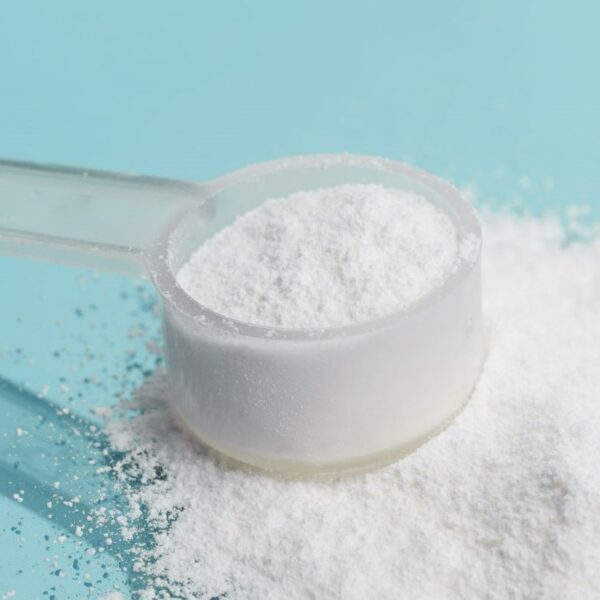Dipotassium Phosphate (DKP), also known as potassium phosphate dibasic, is a water-soluble salt that serves various purposes in the food industry. Its unique properties, including buffering capacity, nutrient content, and sequestration, have led to widespread use. However, like any additive, its application requires understanding its potential effects on health and food quality.
DKP has been used as an additive and preservative in food since the 1940s. Initially, its use was limited to improving shelf life and stability. Later, it was also used to regulate acid and alkaline balance, improve texture, and enhance flavor. Today, it is used in many processed foods. This article explores the use and applications of dipotassium phosphate in food products alongside the associated benefits and potential concerns.
What is Dipotassium Phosphate?
Dipotassium Phosphate (DKP) is a multi-purpose additive in the food industry. It is a dibasic phosphate salt of inorganic nature. It is a synthetic compound obtained industrially by treating phosphoric acid with potassium compounds like potassium carbonate or hydroxide.
Source: Wikipedia
The chemical formula of dipotassium hydrogen phosphate is K2HPO4. It is an inorganic salt composed of two potassium (K+) and phosphate (PO43-) ions—the neutralization of phosphoric acid results in the substitution of hydrogen cations.
DKP Use and Applications in the Food Industry
As an odorless compound with a slightly bitter taste, hygroscopic nature, and a food-grade ingredient, dipotassium phosphate plays many roles in food production. As an effective buffering agent, it helps maintain a steady pH level in food products, thus contributing to stability and longevity. Its sequestrant properties allow it to bind divalent cations, which can impede specific undesirable reactions in food.
Moreover, being a source of phosphorus and potassium, two vital nutrients, dipotassium phosphate also has a nutritional angle to its use. Here is a detailed breakdown of its functions in food products:
| Function | Applications |
| Buffering Agent | Dipotassium phosphate helps maintain a steady pH level in food products, ensuring consistency in taste and structure. |
| Stabilizer | As a stabilizer, dipotassium phosphate aids in preserving the texture and integrity of food products, preventing separation or degradation. |
| Acidity Regulator | As an acidity regulator, dipotassium phosphate helps control the acidity or basicity of food, which can influence flavor, texture, and shelf life. |
| Raising Agent | Dipotassium phosphate chelates or sequesters divalent cations and saves food from oxidation and, thus change in color and taste. |
| Antioxidant, Sequestrant, Chelating Agent | Dipotassium phosphate chelates or sequesters divalent cations and saves food from oxidation and, thus, change in color and taste. |
| Filler | As a raising agent, dipotassium phosphate contributes to the leavening process, helping dough rise and giving baked goods a light, airy structure. |
| Texturizer | Dipotassium phosphate plays a crucial role as a texturizer, helping to give food products a desirable consistency and mouthfeel. |
Nutritional Benefits
Dipotassium phosphate is an excellent and safe source of potassium and phosphates. It is also believed to be beneficial in muscle recovery and is particularly popular among athletes. It can be consumed as a supplement or added to food products for fortification. Also, DPK is an ionic compound used for electrolyte replenishment and total parenteral nutrition (TPN) therapy.
Product Examples
Here are some examples of food products containing dipotassium phosphate:
| Category | Examples | Role |
| Beverages | Soft beverages, Milk based beverages, Flavored beverages, Protein rich beverages | Buffering agent, Stabilizer, Emulsifier, Antioxidant, Dispersing agent |
| Convenience Foods | Powdered foods, Sauces | Stabilizer, Emulsifier, Antioxidant, Acidity regulator, Anti-caking agent |
| Dairy | Cheese, Yogurt, Cream | Stabilizer, Acidity regulator, Anti-coagulant |
| Dairy Alternatives | Non-dairy creamers | Emulsifier, Anti-coagulant, Filler |
| Bakery | Bread, Cake, Cookies | Raising agent, Dough conditioner, Texturizer |
| Snacks | Pasta, Noodles | Dough conditioner, Texturizer, Acidity regulator |
Properties of Dipotassium Phosphate
| Chemical formula | K2HPO4 |
| Molar mass | 174.2 g/mol |
| Appearance | White powder |
| Odor | Odorless |
| Density | 2.44 g/cm3 |
| Melting point | > 465 °C decomposition |
| Solubility in water | 149.25 g/100 ml (20 °C) |
| Solubility | Slightly soluble in alcohol |
| pH (1%) | 8.7-9.4 |
| Acidity (pKa) | 12.4 |
| Basicity (pKb) | 6.8 |
Typical Formulations
One significant application of dipotassium phosphate is in the dairy industry, where it’s used as an emulsifier to prevent coagulation in products like cheese and evaporated milk. It’s also added to powdered products, such as coffee creamers and drink mixes, to avoid clumping and to improve solubility. In the burgeoning plant-based food sector, it’s a key ingredient in many non-dairy alternatives, providing the texture and stability that mimic traditional dairy products.
Cheese
Processed cheese was made by adding emulsifying salts to cheddar cheese, followed by physical and thermal treatment. The formulation consisted of 75% young and 25% aged cheddar cheese. Dipotassium phosphate was added to the formulation at a 1.6-2.6% concentration. The moisture content and fat content increased moderately with increasing concentration of DPK. The meltability as well and texture improved significantly [1].
Non-dairy Creamer
A non-dairy creamer powder was formed by spray-drying an emulsion of the following ingredients.
| Ingredient | % Composition |
| Corn syrup solids | 60.0 % |
| High lauric vegetable fat | 32.0 % |
| Sodium caseinate | 3.5 % |
| Mono/ Diglyceride | 1.5 % |
| Dipotassium phosphate | 2.7 % |
| Sodium Carbonate | 0.3 % |
This formulation has significantly improved resistance to feathering, i.e., precipitation of the serum protein of milk or cream from the dispersion.
Noodles
Instant fried noodles were made with the following formulation. The noodles with added DKP showed significant changes in the pasting properties of starch.
| Ingredient | Composition g/kg basis |
| Flour | 900 |
| Modified potato starch | 100 |
| Water | 340 |
| Salt | 15 |
| Alkaline salt (80% Potassium carbonate + 20% Sodium carbonate) | 1.1 |
| Dipotassium phosphate | 3.0 |
Dipotassium Phosphate Formulation Considerations
Dosage
The dosage of dipotassium phosphate in food products varies per the desired functionality. It ranges from 0.05% to 2% or more.
Annex II to Regulation (EC) No 1333/2008 specifies the maximum permitted limits (MPL) of dipotassium phosphate when used separately or in a mixture with other food-grade phosphates in different food categories [4] [5]. Phosphates are authorized food additives in the EU with maximum MPLs ranging from 500 to 20,000 mg/kg in 104 authorized uses and at quantum satis (QS) in four.
Effect on Properties of Food Products
pH
Dipotassium phosphate helps regulate the pH of food by releasing potassium and phosphate ions when it dissolves in water. It maintains the pH of the medium in which it is incorporated and acts as a buffering agent. pH of 1% aqueous solution of DPK is between 8.7-9.4. Therefore it can help shift the system’s pH towards alkaline when used. It also helps in the stabilization of proteins.
Shelf Life
Dipotassium phosphate enhances the shelf life of food products by contributing to phase stability, oxidative stability, increasing dispersibility, and reducing caking.
Phosphates are slightly bacteriostatic as they slow the growth of some gram-positive bacteria. However, DKP is not considered a natural preservative but can only impart some desirable properties when combined with other food ingredients such as nisin, EDTA, NaCl, nitrites, and erythorbate [6]. The bacteriostatic effect increases in phosphates with the chain length [7]. Moreover, DKP sequesters metal ions (copper, iron, lead) and prevents their prooxidant action. It thus inhibits the oxidation of food ingredients prolonging their shelf life.
Consistency
DKP can be an essential emulsifier in cheese, where it interacts with the milk proteins to promote emulsification. Salts can affect protein conformation to the extent that the anions or cations of the salt could be potential buffer components [8]. Emulsifying salts produce processed cheeses to disperse proteins and lipids and obtain a homogeneous product. Potassium ions replace the divalent calcium ion on the casein, which triggers it’s unfolding to expose lipophilic and hydrophilic ends that emulsify. DKP can help stabilize the protein layer around fat droplets in the milk or dairy alternatives, which helps prevent syneresis and curdling when added to a hot beverage.
The addition of potassium phosphate along with other potassium & sodium salts to block cheese improved the melting properties, flow characteristics, and shape retention without any significantly undesirable flavor profile [9].
Functional Properties
DKP can be used as a flour regulator, dough modifier, buffer, and yeast nutrition agent. It increases the degree of starch gelatinization and the ability of starch to absorb water. It impacts the electrostatic environment, which affects gluten network formation. It, therefore, positively affects instant noodles’ rehydration properties and elasticity. DKP has been shown to improve the pasting properties of instant noodles when used at a concentration of 0.3% [3].
Sensory Profile
Phosphate salts carry a slightly bitter taste. When used at higher concentrations, DKP can impart a bitter metallic taste to food products. However, DKP can significantly impact the retention of food’s sensory properties in flavor and color. It sequesters metal ions and thus prevents the oxidation of sensitive food components.
DKP Safety & Regulatory Considerations
DKP is considered GRAS as a sequestrant under 21 CFR 182.6285. In addition, Despite its utility, dipotassium phosphate is not without potential health considerations. Consumed in large amounts, it may disrupt the balance of phosphates in the body, potentially leading to health complications. However, in the quantities typically used in food, it is generally considered safe by regulatory bodies such as the U.S. Food and Drug Administration (FDA) and the European Food Safety Authority (EFSA).
| FDA Information | DKP is considered GRAS as a sequestrant under 21 CFR 182.6285. It is considered safe for its use in food generally, as a multipurpose food ingredient, up to the limits of GMP. |
Identification Numbers
| EC Number | 231-834-5 |
| E number | E340(ii) |
| CAS Number | 7758-11-4 |
Fun Facts About Dipotassium Phosphate
- DKP plays a vital role in the production of processed cheese. It helps maintain a smooth, uniform texture, preventing the cheese from separating into oil and protein.
- In powdered drink mixes and coffee creamers, DKP is the unsung hero that prevents the powder from clumping and ensures it dissolves smoothly into liquid.
- DKP is often used in fertilizers due to its high potassium and phosphate content. Both elements are vital for plant growth, making it a critical agricultural player.
Additional Resources
- What is Dipotassium Phosphate and What is it Used For?
- Facts on Food Ingredients: Dipotassium Phosphate
- Dipotassium Phosphate – Journal of the Egyptian Society of Food and Analysis
- Dipotassium Phosphate: Antioxidants in Food – University of Bristol
- Potassium Phosphate Dibasic Anhydrous FCC PO205 – Spectrum Chemical
- Registration Decision: Dipotassium Phosphate – U.S. Environmental Protection Agency
- Di-Potassium Phosphate: Supplement Information – Exercise.com
- Article on Dipotassium Phosphate – Alfresco Pharma
Footnotes
- Journal of Dairy Science – PDF
- Google Patents – CA1046836A
- Effect of Phosphate – PDF
- EFSA – Journal of the European Food Safety Authority
- EUR-Lex – Official Journal of the European Union – PDF
- Academic Journals – African Journal of Biotechnology
- PubMed – National Center for Biotechnology Information
- Article on Dipotassium Phosphate – Alfresco Pharma
- ScienceDirect – Food Research International









